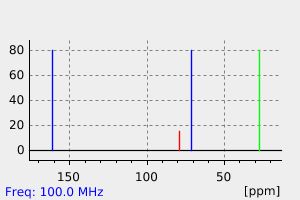N-(prop-2-yn-1-yl)formamide | 14502-66-0
中文名称
——
中文别名
——
英文名称
N-(prop-2-yn-1-yl)formamide
英文别名
propargylformamide;N-propargyl formamide;N-formylpropargylamine;N-prop-2-ynylformamide
CAS
14502-66-0
化学式
C4H5NO
mdl
——
分子量
83.0898
InChiKey
MTEWKKSTWKALQI-UHFFFAOYSA-N
BEILSTEIN
——
EINECS
——
-
物化性质
-
计算性质
-
ADMET
-
安全信息
-
SDS
-
制备方法与用途
-
上下游信息
-
文献信息
-
表征谱图
-
同类化合物
-
相关功能分类
-
相关结构分类
物化性质
-
沸点:248.3±23.0 °C(Predicted)
-
密度:0.983±0.06 g/cm3(Predicted)
计算性质
-
辛醇/水分配系数(LogP):-0.3
-
重原子数:6
-
可旋转键数:1
-
环数:0.0
-
sp3杂化的碳原子比例:0.25
-
拓扑面积:29.1
-
氢给体数:1
-
氢受体数:1
SDS
反应信息
-
作为反应物:描述:N-(prop-2-yn-1-yl)formamide 在 亚硝酸特丁酯 、 N-羟基邻苯二甲酰亚胺 、 三苯基膦双(三氟甲磺酰亚胺)金 、 丙炔酰胺 、 copper diacetate 作用下, 以 四氢呋喃 、 乙腈 为溶剂, 以68%的产率得到噁唑-5-羧酰胺参考文献:名称:一种杂环酰胺类化合物的催化合成方法摘要:本发明公开了一种杂环酰胺类化合物的催化合成方法,包括如下步骤:(1)将炔丙基酰胺类化合物、亚硝酸叔丁酯、氮羟基邻苯二甲酰胺、催化剂和助催化剂加入到含有乙腈或四氢呋喃的耐压密封反应容器中,充入氮气后在50~100℃的油浴中搅拌反应;(2)反应结束后,将步骤(1)的反应产物从上述耐压密封反应容器取出,冷却至室温后,加入乙酸乙酯充分混合,得有机相;(3)旋干步骤(2)所得的有机相中的溶剂,用硅胶柱进行纯化,再用洗脱剂淋洗得到产物,该洗脱剂为石油醚和乙酸乙酯的混合溶液。本发明的催化合成方法在过渡金属的参与下,通过双金属催化反应炔丙基酰胺类化合物得到杂环酰胺类化合物,该反应可以快速构建杂环酰胺类化合物,并且可以选择性得到酰胺化合物。公开号:CN106083755B
-
作为产物:描述:N-formyl-N-prop-2-ynylformamide 在 potassium carbonate 作用下, 以 甲醇 、 甲苯 、 乙腈 为溶剂, 反应 4.0h, 以7.25 g的产率得到N-(prop-2-yn-1-yl)formamide参考文献:名称:Methods for the Synthesis of 5,6,7,8-Tetrahydro-1,8-naphthyridine Fragments for αVβ3 Integrin Antagonists摘要:The preparation of 3-(5,6,7,8-tetrahydro-1,8-naphthyridin-2-yl)propan-1-amine 2a and 3-[(7R)-7-methyl-5,6,7,8-tetrahydro-1,8-naphthyridin-2-yl]propan-1-amine 2b, key intermediates in the synthesis of alpha(V)beta(3) antagonists, is described. The syntheses rely on the efficient double Sonogashira reactions of 2,5-dibromopyridine 3 with acetylenic alcohols 4a/4b and protected propargylamines 10a-e followed by Chichibabin cyclizations of 3,3'-pyridine-2,5-diyldipropan-1-amines 9a/9b.DOI:10.1021/jo0486950
文献信息
-
A substituent- and temperature-controllable NHC-derived zwitterionic catalyst enables CO<sub>2</sub> upgrading for high-efficiency construction of formamides and benzimidazoles作者:Zhaozhuo Yu、Zhengyi Li、Lilong Zhang、Kaixun Zhu、Hongguo Wu、Hu Li、Song YangDOI:10.1039/d1gc01897c日期:——zwitterionic catalyst for efficient CO2 reductive upgrading via either N-formylation or further coupling with cyclization under mild conditions (25 °C, 1 atm CO2) using hydrosilane as a hydrogen source. More than 30 different alkyl and aromatic amines could be transformed into the corresponding formamides or benzimidazoles with remarkable yields (74%–98%). The electronic effect of the introduced substituent近年来,将温室气体CO 2化学催化升级为有价值的化学品和生物燃料引起了广泛关注。在已报道的方法中,CO 2与胺的N-甲酰化由于其在构建含N 线性和环状骨架方面的多功能性而具有重要意义。这里,稳定的N-杂环卡宾-羧基加合物(NHC-CO 2)中制备的轻便和可作为用于高效CO可回收两性离子催化剂2还原升级经由任一Ñ -formylation或另外的耦合用温和的条件下环化(25 °C, 1 atm CO 2) 使用氢硅烷作为氢源。超过 30 种不同的烷基和芳香胺可以转化为相应的甲酰胺或苯并咪唑,产率显着(74%–98%)。发现引入的取代基对NHC-CO 2的电子效应明显影响两性离子催化剂的热稳定性和亲核性,这与其催化活性直接相关。此外,NHC-CO 2可以通过在特定温度下原位脱羧来提供CO 2,这取决于引入的取代基类型。实验和计算研究表明,NHC-CO 2上的羧基物质不仅是亲核中心,而且还是在氢化硅烷化过程中快速捕获或替代环境
-
Facile access to <i>N</i>-formyl imide as an <i>N</i>-formylating agent for the direct synthesis of <i>N</i>-formamides, benzimidazoles and quinazolinones作者:Hsin-Yi Huang、Xiu-Yi Lin、Shih-Yao Yen、Chien-Fu LiangDOI:10.1039/d0ob01080d日期:——N-Formamide synthesis using N-formyl imide with primary and secondary amines with catalytic amounts of p-toluenesulfonic acid monohydrate (TsOH·H2O) is described. This reaction is performed in water without the use of surfactants. Moreover, N-formyl imide is efficiently synthesized using acylamidines with TsOH·H2O in water. In addition, N-formyl imide was successfully used as a carbonyl source in the
-
Catalyst free <i>N</i>-formylation of aromatic and aliphatic amines exploiting reductive formylation of CO<sub>2</sub> using NaBH<sub>4</sub>作者:Arun Kumar、Pankaj Sharma、Nidhi Sharma、Yashwant Kumar、Dinesh MahajanDOI:10.1039/d1ra04848a日期:——Herein, we report a sustainable approach for N-formylation of aromatic as well as aliphatic amines using sodium borohydride and carbon dioxide gas. The developed approach is catalyst free, and does not need pressure or a specialized reaction assembly. The reductive formylation of CO2 with sodium borohydride generates formoxy borohydride species in situ, as confirmed by 1H and 11B NMR spectroscopy.
-
Chitosan: an efficient recyclable catalyst for transamidation of carboxamides with amines under neat conditions作者:Sadu Nageswara Rao、Darapaneni Chandra Mohan、Subbarayappa AdimurthyDOI:10.1039/c4gc01402b日期:——A novel chitosan-catalyzed transamidation of carboxamides with amines under solvent-free conditions is described. A series of amide derivatives as well as more challenging aryl and alkyl amines with long-chain alkyl substituents could be selectively converted into the corresponding transamidation products, which are frequently found in biologically active compounds and pharmaceuticals. Under similar reaction conditions benzo[d]heterocycles were also obtained via a one-pot synthesis through transamidation and subsequent dehydration. Recyclability of chitosan was demonstrated, with quantitative yields of products obtained without any loss of catalytic activity.
-
A NHC-Silyliumylidene Cation for Catalytic <i>N</i>-Formylation of Amines Using Carbon Dioxide作者:Bi-Xiang Leong、Yeow-Chuan Teo、Cloé Condamines、Ming-Chung Yang、Ming-Der Su、Cheuk-Wai SoDOI:10.1021/acscatal.0c03795日期:2020.12.18This study describes the use of a silicon(II) complex, namely, the NHC-silyliumylidene cation complex [(IMe)2SiH]I (1, IMe = :CN(Me)C(Me)}2), to catalyze the chemoselective N-formylation of primary and secondary amines using CO2 and PhSiH3 under mild conditions to afford the corresponding formamides as a sole product (average reaction time: 4.5 h; primary amines, average yield: 95%, average TOF: 8这项研究描述了硅(II)配合物的使用,即NHC-亚甲硅烷基阳离子配合物[(I Me)2 SiH] I(1,I Me =:C N(Me)C(Me)} 2) ,以在温和条件下使用CO 2和PhSiH 3催化伯胺和仲胺的化学选择性N-甲酰化,以提供相应的甲酰胺为唯一产物(平均反应时间:4.5小时;伯胺,平均收率:95%,平均TOF :8 h –1;仲胺,平均收率:98%,平均TOF:17 h –1)。活动1产品收率优于目前用于该催化的非过渡金属催化剂。机理研究表明,与非过渡金属催化剂相比,配合物1中的硅(II)中心通过不同的途径催化C–N键的形成。它依次激活CO 2,PhSiH 3和胺,这些胺通过二氢消除机理进行反应,形成甲酰胺,硅氧烷和二氢气体。
表征谱图
-
氢谱1HNMR
-
质谱MS
-
碳谱13CNMR
-
红外IR
-
拉曼Raman
-
峰位数据
-
峰位匹配
-
表征信息
同类化合物
(甲基3-(二甲基氨基)-2-苯基-2H-azirene-2-羧酸乙酯)
(±)-盐酸氯吡格雷
(±)-丙酰肉碱氯化物
(d(CH2)51,Tyr(Me)2,Arg8)-血管加压素
(S)-(+)-α-氨基-4-羧基-2-甲基苯乙酸
(S)-阿拉考特盐酸盐
(S)-赖诺普利-d5钠
(S)-2-氨基-5-氧代己酸,氢溴酸盐
(S)-2-[[[(1R,2R)-2-[[[3,5-双(叔丁基)-2-羟基苯基]亚甲基]氨基]环己基]硫脲基]-N-苄基-N,3,3-三甲基丁酰胺
(S)-2-[3-[(1R,2R)-2-(二丙基氨基)环己基]硫脲基]-N-异丙基-3,3-二甲基丁酰胺
(S)-1-(4-氨基氧基乙酰胺基苄基)乙二胺四乙酸
(S)-1-[N-[3-苯基-1-[(苯基甲氧基)羰基]丙基]-L-丙氨酰基]-L-脯氨酸
(R)-乙基N-甲酰基-N-(1-苯乙基)甘氨酸
(R)-丙酰肉碱-d3氯化物
(R)-4-N-Cbz-哌嗪-2-甲酸甲酯
(R)-3-氨基-2-苄基丙酸盐酸盐
(R)-1-(3-溴-2-甲基-1-氧丙基)-L-脯氨酸
(N-[(苄氧基)羰基]丙氨酰-N〜5〜-(diaminomethylidene)鸟氨酸)
(6-氯-2-吲哚基甲基)乙酰氨基丙二酸二乙酯
(4R)-N-亚硝基噻唑烷-4-羧酸
(3R)-1-噻-4-氮杂螺[4.4]壬烷-3-羧酸
(3-硝基-1H-1,2,4-三唑-1-基)乙酸乙酯
(2S,4R)-Boc-4-环己基-吡咯烷-2-羧酸
(2S,3S,5S)-2-氨基-3-羟基-1,6-二苯己烷-5-N-氨基甲酰基-L-缬氨酸
(2S,3S)-3-((S)-1-((1-(4-氟苯基)-1H-1,2,3-三唑-4-基)-甲基氨基)-1-氧-3-(噻唑-4-基)丙-2-基氨基甲酰基)-环氧乙烷-2-羧酸
(2S)-2,6-二氨基-N-[4-(5-氟-1,3-苯并噻唑-2-基)-2-甲基苯基]己酰胺二盐酸盐
(2S)-2-氨基-N,3,3-三甲基-N-(苯甲基)丁酰胺
(2S)-2-氨基-3-甲基-N-2-吡啶基丁酰胺
(2S)-2-氨基-3,3-二甲基-N-(苯基甲基)丁酰胺,
(2S)-2-氨基-3,3-二甲基-N-2-吡啶基丁酰胺
(2S,4R)-1-((S)-2-氨基-3,3-二甲基丁酰基)-4-羟基-N-(4-(4-甲基噻唑-5-基)苄基)吡咯烷-2-甲酰胺盐酸盐
(2R,3'S)苯那普利叔丁基酯d5
(2R)-2-氨基-3,3-二甲基-N-(苯甲基)丁酰胺
(2-氯丙烯基)草酰氯
(1S,3S,5S)-2-Boc-2-氮杂双环[3.1.0]己烷-3-羧酸
(1R,5R,6R)-5-(1-乙基丙氧基)-7-氧杂双环[4.1.0]庚-3-烯-3-羧酸乙基酯
(1R,4R,5S,6R)-4-氨基-2-氧杂双环[3.1.0]己烷-4,6-二羧酸
齐特巴坦
齐德巴坦钠盐
齐墩果-12-烯-28-酸,2,3-二羟基-,苯基甲基酯,(2a,3a)-
齐墩果-12-烯-28-酸,2,3-二羟基-,羧基甲基酯,(2a,3b)-(9CI)
黄酮-8-乙酸二甲氨基乙基酯
黄荧菌素
黄体生成激素释放激素(1-6)
黄体生成激素释放激素 (1-5) 酰肼
黄体瑞林
麦醇溶蛋白
麦角硫因
麦芽聚糖六乙酸酯
麦根酸







